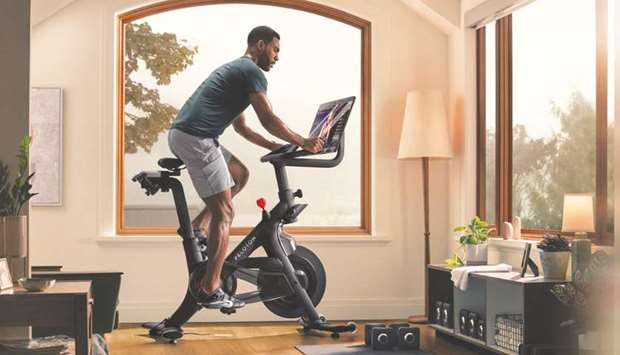Is that thundering on the floor in the flat above ever going to stop, or is it just the short bit where your upstairs neighbour does a few burpees before collapsing (another thud) in a heap? If you are the one making the noise, does the weight of your guilt count as extra resistance? For the sake of indoor exercisers and flat-dwellers everywhere, here are some expert tips on keeping the noise down.
Low impact doesn’t mean low effort
When one woman had a visit from the police, who said her neighbours had made a noise complaint, she realised it was probably from the HIIT class she was doing. She had signed up to one of the online classes offered by pilatespt.co.uk, set up by Hollie Grant, a personal trainer. “We do have people messaging us if they’re thinking of signing up, saying: ‘I live in a flat, how jumpy will it be?’,” says Grant. There are some squat jumps and other “bouncy” movements in her classes, but she always offers lower-impact options to postnatal women and those with joint issues or pelvic-floor problems. “Low-impact options don’t mean easy,” she says.
Make low-impact substitutions
Instead of jumps, do squats, lunges and deadlifts. “If you do them at a certain speed, and with enough repetitions, you would get your heart rate up,” says Grant, though she points out that it probably wouldn’t go as high as if you were doing squat jumps or plyometric lunges (where you jump from a lunge position when switching legs). “What you would have to do is add resistance, so using things such as resistance bands or dumbbells would increase your heart rate, and would make up for the fact that you’re not jumping around.”
Cardio is not just about running
You don’t need to run on the spot (or jump). “Anything that gets your heart rate up is cardiovascular exercise,” says Nick Mitchell, the founder and CEO of Ultimate Performance, a global personal training business. This includes bodyweight exercises such as squats, lunges and pushups, which can all be done quietly. He isn’t a fan of jumping movements anyway, particularly for those of us who are overweight and with decades of sedentary behaviour behind us. For most people, he adds, these options will be easier on your joints but can be even harder – and will get you fitter – than going for a jog, where most people run at a single pace and your body adapts. Depending on starting fitness levels, “the best thing to do is to pick movements that are hard and you do those movements with intensity and effort for 30 to 60 seconds, and then you either do something slower – what you might call active recovery – or if you’re fit enough, you go into a different movement that works a different part of your body”.
Try to land quietly
If you are desperate to keep doing the jumpy stuff, try to be light-footed. Grant says: “In our HIIT class, we’ll say: ‘This is high-intensity, but it shouldn’t be high-impact. Imagine there’s a baby in the room and you don’t want to wake them up, so if you are doing squat jumps, try to land quietly.’ Actually, it’s much harder for the body to land quietly, so you make your workout harder if you try to create the least amount of noise possible when you land.” It should also make it lower-impact on your joints.
Turn down the volume
Grant suggests exercising on two yoga mats or putting a folded towel underneath one to muffle a thud. Also ditch the clumpy trainers. “In our HIIT classes, we ask people to be barefoot.” It’s more challenging, and helps you better control your landing. “You have to use more muscles in your ankle and foot, you don’t just have a trainer holding you in position, so it’s better for you and you’ll activate more muscles.” Your calves may be more achy the next day, “and the arches of your feet can feel bruised – it’s not bruising, it’s that you’re activating muscles that are not given the opportunity.”
Invest wisely in equipment
A treadmill may be noisy, but can you get a good workout from a rowing machine or stationary bike? Only if you use it properly, says Mitchell. “Go hard. We all have different ability levels, so it’s not that you must get your bike up to 20mph. You’ve just got to try as hard as you can for a given unit of time.” Exercise should be progressive, he says. “Set some goals. On a rowing machine, for instance, set yourself three one-minute rounds. For one minute, go as hard as you can, measure the distance, then get up and walk around.” On the next round, see if you can beat the distance, and keep doing it. “And then you’ve got a goal to beat for the next time.” After a few days or weeks, add more rounds. “If you can do 10 one-minute rounds, going hard, you’ll be so much fitter than when you started.” Mixing all-out effort for 30 to 60 seconds, then resting for up to two minutes, then repeating it several times is “the best way to get in shape – meaning lose fat and get your fitness up to maximum levels”. If you’re determined to build a home gym, the best equipment, he says, is “the thing that you enjoy the most because if you enjoy it, you’re going to do it”, pointing out that most exercise bikes end up as clothes hangers.
But you don’t need to spend loads on weights
“Be creative with what’s around the house,” says Grant. “Anything can be a ‘weight’, it doesn’t have to look good. A litre bottle of water – that’s a kilogram.” Mitchell recommends getting two carrier bags and putting a couple of tins (wrapped in a towel to reduce the clunking) in each. “Squat down, hold the bags at shoulder height, stand up and then push your arms overhead, being careful not to smash yourself on the side of the head with the bags.” That would be much more effective than a bounding movement, he says, as it works the whole body. “The beauty of weight training – sticking tins in bags – is you can always stick more tins in as you get stronger.”



